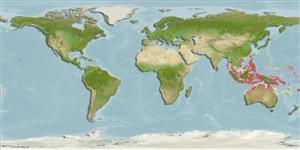>
Ovalentaria/misc (Various families in series Ovalentaria) >
Pomacentridae (Damselfishes) > Pomacentrinae
Etymology: Pomacentrus: Greek, poma, -atos = cover, operculum + Greek, kentron = sting (Ref. 45335).
More on author: Bleeker.
Environment: milieu / climate zone / intervalo de profundidade / distribution range
Ecologia
marinhas associadas(os) a recifes; não migratória; intervalo de profundidade 0 - 10 m (Ref. 7247). Tropical; 35°N - 35°S
Indo-West Pacific: Indonesia (Mentawai Islands), Philippines, Palau, Papua New Guinea, Solomon Islands, Vanuatu, north to the Philippines, Taiwan, and Ryukyu Islands. Reported from New Caledonia (Ref. 26587).
Tamanho / Peso / Idade
Maturidade: Lm ? range ? - ? cm
Max length : 7.0 cm SL macho/indeterminado; (Ref. 7247)
Descrição breve
Chaves de identificação | Morfologia | Morfometria
Espinhos dorsais (total) : 13; Raios dorsais moles (total) : 14 - 16; Espinhos anais: 2; Raios anais moles: 14 - 15.
Body shape (shape guide): short and / or deep; Cross section: oval.
Adults occur singly or in small aggregations at slightly turbid areas of lagoon and coastal reefs. Feed mainly on benthic algae (Ref. 7247). Oviparous, distinct pairing during breeding (Ref. 205). Eggs are demersal and adhere to the substrate (Ref. 205). Males guard and aerate the eggs (Ref. 205). Diurnal species (Ref. 52881).
Life cycle and mating behavior
Maturidade | Reprodução | Desova | Ovos | Fecundidade | Larvas
Oviparous, distinct pairing during breeding (Ref. 205). Eggs are demersal and adhere to the substrate (Ref. 205). Males guard and aerate the eggs (Ref. 205).
Allen, G.R., 1991. Damselfishes of the world. Mergus Publishers, Melle, Germany. 271 p. (Ref. 7247)
Categoria na Lista Vermelha da IUCN (Ref. 130435: Version 2024-2)
Ameaça para o homem
Harmless
Utilização humana
Pescarias: pescarias de subsistência
Ferramentas
Relatórios especiais
Descarregue XML
Fontes da internet
Estimates based on models
Preferred temperature (Ref.
123201): 26.9 - 29.3, mean 28.7 °C (based on 1958 cells).
Phylogenetic diversity index (Ref.
82804): PD
50 = 0.5000 [Uniqueness, from 0.5 = low to 2.0 = high].
Bayesian length-weight: a=0.02399 (0.01396 - 0.04123), b=2.94 (2.79 - 3.09), in cm total length, based on LWR estimates for this species & Genus-body shape (Ref.
93245).
Nível Trófico (Ref.
69278): 2.7 ±0.29 se; based on food items.
Resiliência (Ref.
120179): Elevada, tempo mínimo de duplicação da população menor que 15 meses (Preliminary K or Fecundity.).
Fishing Vulnerability (Ref.
59153): Low vulnerability (10 of 100).
🛈
Nutrients (Ref.
124155): Calcium = 161 [78, 256] mg/100g; Iron = 0.87 [0.51, 1.49] mg/100g; Protein = 18.2 [17.0, 19.3] %; Omega3 = 0.111 [0.062, 0.189] g/100g; Selenium = 18.2 [9.7, 36.3] μg/100g; VitaminA = 107 [30, 361] μg/100g; Zinc = 2.12 [1.39, 3.17] mg/100g (wet weight);
